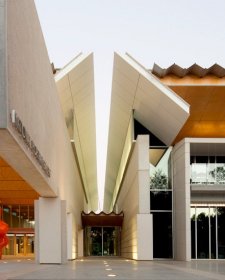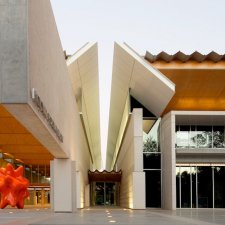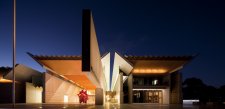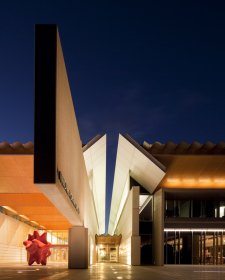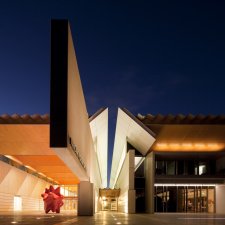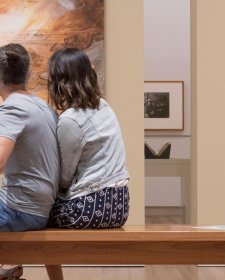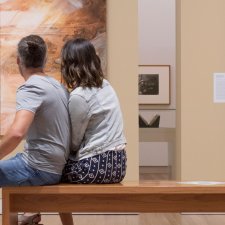16th of September 1975, where was I? I had just graduated and set in a workshop because I did a BA and I was one of the newly graduates from UPNG and I was selected to teach at a national high school, so I remember that.
But on that day, where was I? I was with my family, because my elder brother had a house on Airvos Avenue, just above the Sir Hubert Murray Stadium, where the main event was going to take place. And we watched it from there, and I recall those amazing emotional memories of that day.
And I'm really honored to be here on 16th of September here in Australia. So how did I get here? Well, I was an Australian citizen, but then it got taken off me in 1975 and it took from 1975 to June 2002 to get it back. So now I am an Australian citizen and that's how I ended up at ANU and became the first Pacific Collections Librarian for the Pacific Studies at ANU in 2006.
So how did I come to know about the Elizabeth Durack Collection at the Menzies Library? Out of the blue in 2015, we got this letter of general inquiry from Perpetua Durak Clancy and Michael, they were the children of Elizabeth Durak. And as soon as I saw it, I knew that collection, because I had that book, Face Value. And when I looked through all of those images, I said, we must have this collection. And this was 2015, 2016. And this was 2015. The Australian dollar was really weak against the U.S., and the university library administrators put a freeze on spending. So we were really caught, but I was desperate to get this collection. And 2016, and by 2017, I was planning to retire. And I wanted to really leave something significant when I left my professional library career. And lo and behold, they lifted the freeze. And we were asked to spend, this is towards the end of 2016, spend the money. And this was a big ticket item, Elizabeth Durak collection.
So obviously, Perpetua and Michael contacted me again by October 2016. And I said to them, we are in luck, I think. We will put in a bid. And fingers crossed and everyone pray that it will get approved and we will get this collection. And this collection was delivered on 29th of January, 2016. And I retired at the end of December 2017. So, yes, my dream of coming to ANU and discovering this amazing collection because that book, Face Value, had amazing drawings and sketches done by Elizabeth Durak in 1968. And, you know, over 400 sketches were done.
So how did Elizabeth get selected to go to PNG in 1968? Well, this was a pivotal time, because this was when the questions of self-government and eventual independence were beginning to be discussed. In 1968, I was at a boarding school, up at Sogeri. And so we weren't really politically minded then. We were just attending school and going along and not really worrying about anything. We were Australians we were going to remain there forever, like my mother thought. They were not going to ever leave because everything was working so well. But Gough Whitlam came in, and of course he was under pressure from the UN to decolonize. And of course, 16th of September, 1975, it all happened.
And so I was one of those graduates that were then what we call localization. So we had just graduated from UPNG with our first fresh degrees. and no work experience. So I was sent to high school to teach. Anyway, to cut the long story short, I then, it was amazing the way it happened for me, how I ended up to become a librarian. I was posted to Aiyura National High School is in Kainantu Eastern Highlands Province. And this was in 1976. And I was posted there to teach. I was the only Papua New Guinean on the teaching staff of the school. Everybody was from all over the world. And the paymaster at the Goroka office didn't think there would be Papua New Guineans teaching at this school, so he never sent on my paycheck. So I didn't get paid for six months.
So those are the experiences of a new independent country because everything was all kind of up in the air. There were Papua New Guineans who were selected to understudy their Australian bosses to take over from them when their time came to return to Australia. So I was one of those. And then because I didn't get paid, I resigned. And then I was just kind of unemployed. And I saw this ad in the Post-Courier newspaper of trainee librarians. And I only applied because it promised a postgraduate scholarship to the UK. So I was very lucky I applied and I got appointed. And the first thing was they told me that, yes, I would go on a British Council scholarship to Aberystwyth to train as a professional librarian. So I was one of the first Papua New Guineans. And Florence Griffin, who you will see come up later, was one of them.
So from that time, then I then moved to Nouméa, New Caledonia, as that's the South Pacific Commission. Then it was called Librarian. I spent six years there. And then we came to Canberra. And of course, at the ANU, this collection, sorry, I regard as my parting gift because I really wanted this collection. wanted this collection to be held as a research collection at the ANU. And of course, when the approval was given to acquire this collection, we had to get academics to support this collection. So I got Professor Chris Ballard, Dr. Anne Luca. And they obviously wrote this amazing glowing references on why this collection should be acquired by ANU. And so this is how this collection came about. And for me, because of that book Face Value, and because I was New Guinea Collection Librarian, then I knew some of the images in this.
And Alice Wedega, you will see, is one of my heroines, I suppose I could say. I knew her personally because she was one of this amazing Papuan, when I say Papuan, there's Papua and New Guinea then, Papuan women who really just somehow made it into this male-dominated society. And as some of you know, there is Australian Biographical Dictionary entry that Eric Johns has written. And she obviously became the first woman to join the Legislative Assembly, the House of Assembly then, in the 1960s. But before that, because of her education and training in Mission School. So this was, she was LMS, London Mission Society, and then Kwato Mission.
So she developed this amazing way of getting this message out to communities or tribes in our interland communities. Like there were two amazing tribal communities who were enemies in our area. At the time, Alice Wedega was going to be given the responsibility to come and visit them. And some of you probably have heard of F.E. Williams as well. He spent time in the 30s in this area. So the tribal names of these groups are Dorevaidi and Keveri. And they were really warlike. And Hubert Murray, who was the governor of Papua at the time, to have found it really difficult to convince these people to give up their ways of killing each other and come and join the the ways of the government or the ways of this new life. And Alice Wedega somehow managed to get into the mentality of these warfare tribes and convince them.
And so as you can see on this image of Alice Wedega, the way she's wearing her hair, we call this Papua Ekalesia hairstyle. So traditionally, they would have worn their hair Afro style. But in this, she's wearing it all folded at the back. And my mother's generation, this is the way they were shown how to comb their hair, arrange their hair, to indicate that they were members of this church group, or LMS, Kwato Mission, or Kwato Extension Association, when Alice Wedega was really in the hinterland of our about area. And I chose Alice Wedega because, as I said, she would come to visit these interlearned communities. And quite often she would end up coming to our village because our villages were built on stilts over the sea on the coast. So their boat would come and pick them up and take them to Milne Bay, the Kwato Mission, where she was based. So that's how I knew her as a child. And even then, I just thought she was just an amazing looking woman. And to see her, when I opened that book by Elizabeth Durak, and see her, it's a wonderful image and brings up so many amazing images to me.
But the next slide, this is Alice Wedega at the time. So this is 1915. So in the 50s, Alice Wedega was around that area. And some of these images you will see were the ones that were converted and changed their old ways and became absolute gentlemen. And so some of these people would have come through our family home and we would have entertained them, but then we didn't know anything about their past. And with this image comes my own very personal story of Alice Wedega's book, Listen My Country. In her book, she writes about a murder that took place of a Wanigela man. Wanigela is my paternal tribal people. And my grandfather was murdered by people like this, you see. And I've always wondered when I saw this, when Kari recruited me to work for the Pacific Manuscripts Bureau three or so years ago. This is the first collection she got me to work on.
Henry Dexter was an enlishman and he was one of those who wanted adventure and all that. So he ended up in Papua New Guinea and was sent up to Automata Plantation to start a copper plantation there. And about is not far from where that plantation was. So it was an an amazing experience to go in and work on that day. And Kari said, this is the collection they will look at and look at if the captions are correct. So that's what I worked on. And as soon as I saw this, I recalled Alice Wedega's book about the murder of my grandfather, and I always wondered whether one of these men had murdered my grandfather. So that's the connection.
And so the Pacific Manuscripts Bureau here are holding of these prisoners. And Alice Wedega from the Elizabeth Durak drawing held at the Menzies Library Pacific Manuscript. So that connection is amazing. And to go on to the next slide, Veitu Apana Hau'ofa. Again, I saw this image and I knew Veitu Hau'ofa. But she was Miss Apana then. And then when I knew her, she was teaching at the Hohola Demonstration School, a suburb of Port Moresby. And we knew her then as Miss Apana, and then now she was Mrs. Hau'ofa. But then, that school teacher image changed very quickly because she then became one of our Papua New Guinea's leading sports personalities. And she's still going strong at close at 80. And recently in 2002, was became one of the inductees of the sports Hall of Fame in Papua New Guinea. And so Mrs. Hau'ofa and I used to come across at the sports grounds quite a lot because she used to coach a mens softball team. And my village people also had a softball team in Port Moresby and we were great rivals. And we would often meet and his, her team would play against us. So through that connection with playing softball. We knew her really well then. And because of that relationship, we, their children called me uncle. And apparently, her son, Siale Diro is now the defense attach here at the PNG High Commission. So that connection of family knowing her and her son here and seeing her image in Elizabeth Durak sketches is just amazing. But she, as I said, is still strong and contributing actively to Papua New Guinea sports, mostly in the codes of netball and basketball and softball. But above all, a sports administrator. And I think she's still going strong in those areas.
So the next images of Veitu Apana, this was taken in 1962. And this image from Robert Pulsford Collection. Now, Robert Pulsford Collection also came about, because when Kari came and shared coffee with me that I was to start as Research Officer at the Pacific Manuscripts Bureau, she said, this Robert Pulsford family contacted me. And because he was born in the Pacific and Papua New Guinea collection. So you must come with me to their home in Ainslie to check through what they want to give to the Bureau. But that morning, it was a Friday I turned up and I said, well up to you, you are the boss. So I joined Kari and we drove to this home in Ainslie. And the focus was to just a collection of pamphlets and books and things they had at the corner of their home. And we checked through all those. And unfortunately, most of them were already held at the Menzies Library. So we said, sorry, we can't take these.
But then we were just about to get up and go when the wife said, are you interested in photographs? And we both said yes. So they both disappeared into the study and came out handfuls of these albums. and as they were placing them on the dining table, one of the images fell out on the floor right way up. I looked down and I couldn't believe my eyes. I said, this is amazing. This is the chief of my village. And Ian, the son said, I don't believe you, Deveni. I said yes. I can name every single one of those people in that photograph. And then they said, oh, we got the rest of the album and they brought it out. And we flipped through. The next page was my brother, who was a medical student, taught by Robert Pulsford at the Papuan Medical College, UPNG, and we turned more pages. And there's a whole group of my village people, over 40 images taken in 1972. And through those albums is this amazing woman, then, Veitu Apana, now Mrs. Veitu Diro. And again, you will see her hairstyle there. But in the 68 drawing that Elizabeth did, it was Afro style. And that was at the time anyway. Remember, this was the late 60s, 70s. Yeah, Afro, black is beautiful. And platform shoes, flared jeans. That was the period. when I knew her at the Hohola Demonstration School, and in 1968, that six years later, Elizabeth Durak was up in PNG.
So how did Elizabeth Durak get up there? It was the Department of External Territories, and it was Mr. Barnes, who was the Minister for External Territories. As far as I could understand, it was this reception that They were talking, and then Mr. Barnes said, oh, we want somebody to go up to find out how the PNG women are doing at this time of development. And Elizabeth Durak put her hand up. And of course, she was the right person because the family, pastoral family from Western Australia and knew a lot about indigenous people. And you know her work. One of the controversy was the Barap. Yeah, that she was painting under the pseudonym. Anyway, it got revealed, but it's a wonderful revelation as far as I'm concerned. But so when I looked at the book Face Value and seen through the eyes in Papua New Guinea, the another volume that she compiled on a visit to Papua New Guinea and traveled all over Papua New Guinea from Port Moresby to Lae, Wau, Bulolo, Goroka, Kainantu , up to the highlands, the Sepik went on to the islands, Rabaul, Manus, everywhere, within that short period of time. How did this amazing woman got these women to sit down and draw their face value? I like that title because some of these images at the time still Karid their traditional traditional tribal tattoos and you will see when you access this collection through the Menzies library at the library website you will see some of them have tribal markings and that what she means she says I look into these faces and I can see their family connections, their stories that trace them back to time immemorial and I mean to me that's just amazing to some people looking at these images when you access them online you think they're just images but to a Papua New Guinean and looking at them like making the connection with Alice Wedega and Veitu Apana those connections so because I knew them personally and the connections they bring through my the murder of my grandfather and Veitu now a revered sportswoman in our country it is amazing.
And so the next image is Florence Griffin. She's my dear friend. I knew her when I was an undergraduate student. She was an undergraduate student. She was the assistant New Guinea Collection librarian. And because we got on really well, I often visited her. And we did know that in 1979 we would all both be given British Council scholarships to go to Aberystworth and train to be first Papua New Guinea and professionally qualified librarians. So Florence Griffin, she comes from Daru, Western Australia, TI connection, very strong, and comes from a family of missionaries. And so some of you feel if you do Mr. Google, Florence Inabi, I-N-A-B-I, married name Griffin. It will see what she said. So in 1966, she was one of six women who were enrolled at UPNG. And if you read those names of the men who were enrolled at the time, Rabbie Namaliu, former Prime Minister, Charles Lepani, who was the High Commissioner here, and Leo Hannett, all those people played amazing roles, and she was one of them. Anyway, so out of those six who enrolled in 1966, Florence and one other woman completed their degrees. And so when the chance came for us to meet up and go to, Aberystworth in in 1979, I said to her, you know, I mean, I didn't know that you were famous in Elizabeth Durak's book. You are there. And then we looked at the picture, and I said, yes, it was 68. That's right. It was Afro. And she said, yes, that's how I attracted my husband, Bill Griffin. It was really funny. Anyway, so we were both very lucky. We became close friends and the last correspondence I had with her was in October 2010. She left UPNG Library because of problems with the library's been supported because she struggled to get the acquisitions budget to be passed to buy more books and subscribe to journals and things like that she got frustrated and left and ended up, her last days were spent at the National Library of Papua New Guinea in Port Morseby as reference or Reader Services Librarian. That's where we, my family and I met her at the counter at the National Library of Australia.
And to Florence Griffin, she was an amazing woman in that she said when she was asked by a journalist in 19, was it 67, I think she was second year then. And so are you going to go back to your home? She said, no, I will never go back to my home in Daru because a lot of people in my village think me leaving my mum and not staying in home to help her coming to have this university education was not the right in their eyes, very traditional views and attitudes. So she came from that background, you know, she was one of those who said, well, I'm going to go and become a graduate and become a librarian. And then she became the first university librarian at UPNG, Michael Somare Library, now it's called, and I became the first university librarian at the Papua New Guinea University of Technology in Lae. And Kari and I were there recently, look at another national significant collection of traditional architectural styles at the architecture department in Lae.
And so with those connections with Dame Alice Wedega, Veitu Apana and Florence Griffin and my personal connections and friendships with them, I suppose I've been very lucky to have made it to Canberra and to find my people in the albums of the Pulsford in a home in Ainslie I mean really this is really true I often wondered when I came here I wonder if there would be anything from my home that will be held by one of these Australians who spent time in Papua New Guinea and amazing how the connection was made when Kari recruited me to become research officer at the Pacific Manuscripts Bureau. Yeah, so I'm happy and it's just been an amazing experience to discover Elizabeth Durak of 400's images of this amazing PNG women and of course Robert Pulsford collection and the Henry Dexter collection from the Bureau. Thank you.

